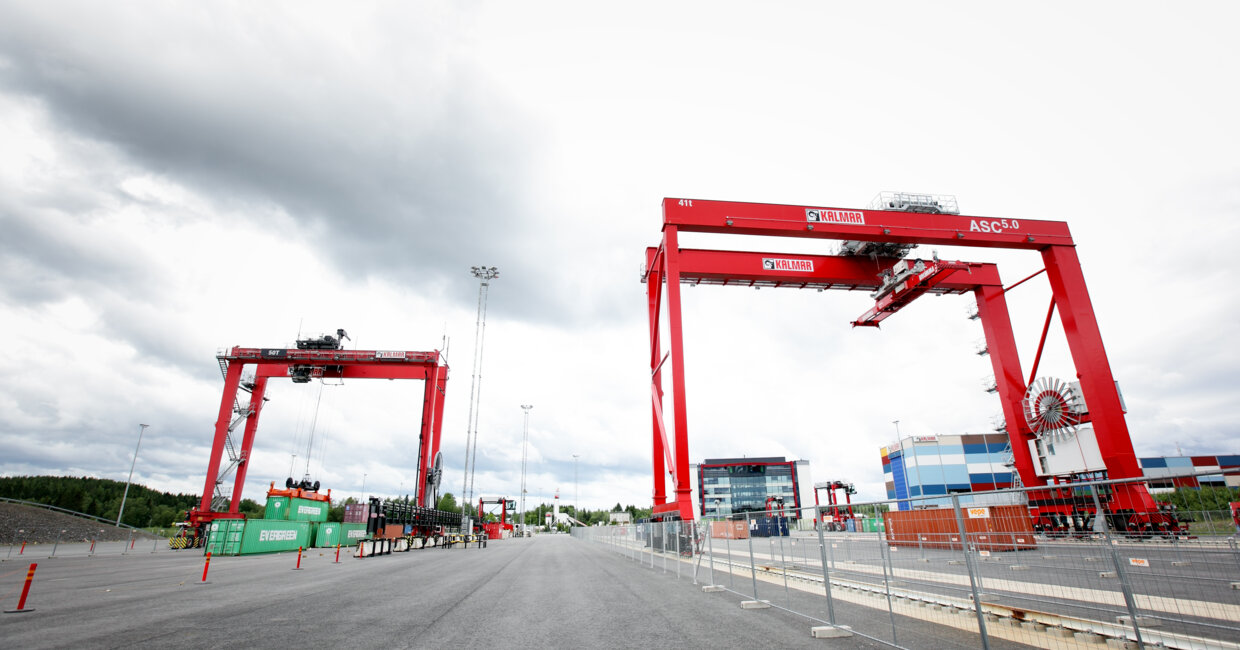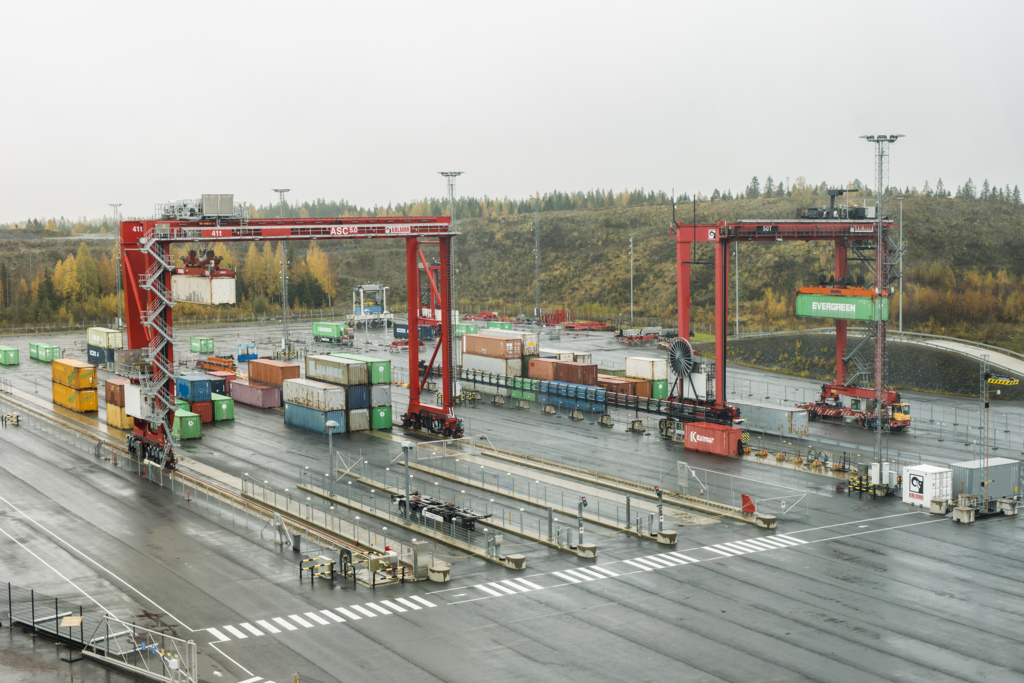
Kalmar explores digital transformation of ports through wireless connectivity
Kalmar collaborates with Nokia, Telia and Digita to enable greater port automation through private wireless connectivity and industrial devices.
Kalmar is committed to meeting the ever-growing operational demands of busy ports by investigating and testing new automation capabilities and techniques at one of the industry’s largest port automation test fields in Tampere, Finland. Opened in 2013 to advance port automation technologies, Kalmar is able to simulate, test, monitor and optimise innovative communications and cargo handling solutions for port operator customer projects and new product releases.
To advance capabilities across the centre and take advantage of widespread automation Kalmar, together with telecommunications network operator Telia, Telia’s partner Digita and Nokia have implemented an end-to-end industrial-grade private 4G and 5G wireless network using the Nokia Digital Automation Cloud (DAC) solution. Integrated Nokia Industrial user equipment will enable people and machines to stay connected within the infrastructure.
Kalmar has implemented an end-to-end industrial-grade private wireless network to its test yard.
"Kalmar's example shows that industrial 5G is now evolving to deliver on the promises that have been placed on the technology. It is great to see that Finnish companies are at the forefront of the world in demonstrating how 5G brings real business benefits through increased efficiency and security," says Janne Koistinen, Director of Telia's 5G Programme.
"The state-of-the-art private network is always adapted to the customer's needs, in Kalmar's case it means delivering and building the latest network technologies to promote product development," says Henri Viljasjärvi, Business Development Director at Digita.
Industrial wireless connectivity for the digital transformation of ports
As the demand for container shipping services continues to grow across the globe, today’s ports are being challenged to efficiently manage a growing mix of vessels in the fastest time. To maximise turnaround, storage and assets, port operators need to focus on decreasing loading and unloading times and ensuring goods and vessels can move quickly on to their next destination.
To optimise operations, many ports are embarking on their digital transformation and focusing on automation and remotely operated equipment such as cranes and straddle carriers. This will allow them to manage fluctuating demands and volumes of containers entering and leaving the port with the least disruption and highest efficiency while maintaining the safety of any personnel on-site.
Private 4G and 5G wireless networks are ideally suited to these environments. Offering low-latency and pervasive connectivity, they can connect many more sensors, machines and people in real-time to enable Industry 4.0 capabilities, allowing authorities and cargo owners to gain greater control over their operations. In addition to enhancing operational flexibility, automation will provide many other benefits, including limited environmental emissions and reduction of interruptions. Automated terminals deliver reliable and consistent performance day after day.
Seamless connectivity to automate maritime operations using Nokia Industrial devices
To take advantage of widespread automation, Kalmar, Telia, Digita and Nokia have deployed Nokia 4G and 5G industrial private wireless capabilities using the Nokia Digital Automation Cloud (DAC) application platform, together with Nokia Industrial devices. Nokia DAC provides connectivity with pervasive coverage as well as the reliability and low latency required to connect myriad sensors and devices in real-time. It offers computing capabilities and the ability to run applications locally while keeping data securely on site.
One of the challenges in automating the port environment is how to connect machinery into a private wireless network. The reason is that equipment such as forklift trucks, cranes and straddle carriers aren’t compatible with the SIM cards used to connect handheld mobile devices. In fact, they are traditionally designed with USB ports or Wi-Fi connectivity in mind. But Wi-Fi doesn’t offer the reliability or coverage required for true automation in these challenging environments, where metal containers and other structures often obstruct wi-fi signals.

Pre-tested ruggedised devices designed for any industrial environment
By implementing Nokia DAC, Kalmar could also take advantage of Nokia Industrial user equipment designed with connectivity issues in mind. Kalmar has incorporated Nokia Industrial fieldrouters and dongles, which are equipped with their own SIM cards to connect machinery to the private wireless network. In fact, to ensure compatibility with equipment, Nokia continues to work with Kalmar to pre-test and validate devices at the Technology and Competence Center.
But it doesn’t just stop at connectivity. Nokia Industrial devices are designed to work in harsh and remote environments. Ports are exposed to turbulent weather conditions and equipment can take the strain. Nokia Industrial user equipment is purpose-built with a ruggedized and anti-vibration design that can withstand movements in both automated and manually operated machinery.
“We understand the need for high-availability of equipment in any industrial environment. Any downtime costs money when ports are tasked with servicing huge freight vessels. It’s all about durability and reliability. That’s why we have designed and created the portfolio of Nokia Industrial devices optimized for these environments – for fast on-boarding of the equipment and to keep operations running smoothly,” says Venkatesh Ramakrishnan, Head of Maritime Vertical, Nokia.
By deploying Nokia fieldrouters within its automated straddle carriers, a ‘heartbeat’ signal is maintained on the network, allowing personnel at the control centre to stop and start operations in a fraction of a second to ensure safety and efficiency. Nokia fieldrouters maintain the reliability of operations as straddle carriers at the Technology and Competence Center simulate the movement of containers from the quay to the container yard. For manned equipment such as empty container handlers, Nokia Industrial dongles deliver vital connectivity to the Enterprise Resource Planning (ERP) system, providing empty container handler drivers with their work schedules.
Now we can increase automation as we continue to deliver innovative solutions that will benefit our customers.
“By implementing the Nokia Industrial fieldrouters and dongles within straddle carriers, cranes and mobile machines we can rely on them staying connected to the control centre. It has allowed us to increase automation as we continue to deliver innovative solutions that will benefit our customers,” says Toni Söderlund, Vice President, Products & Solutions, Kalmar.
A clear view of operations and devices
Nokia DAC self-service tools are an integral part of the end-to-end private wireless solution. Using the Nokia DAC manager web portal, customers such as Kalmar can manage the network and leverage the Device Management section to manage their equipment. They can also use DAC manager to access and load applications to devices from the Nokia DAC catalogue.
As a Nokia Industrial device is introduced, it connects to the network and is recognized by the Nokia Device Management, receiving the latest firmware update. Updates are deployed from the network edge, ensuring devices remain secure within the private wireless network.
Kalmar can monitor and optimize its entire network and all connected devices. Any changes to performance or issues will trigger an alert, allowing Kalmar to make swift decisions based on that information. The ability to group devices allows Kalmar to create actions at a group, rather than individual level. Kalmar also has the ability to control when firmware updates are delivered, so vital operations and test activities are never interrupted.
Related articles
Further reading
Subscribe and receive updates in your email
Meld je aan voor onze publicaties










